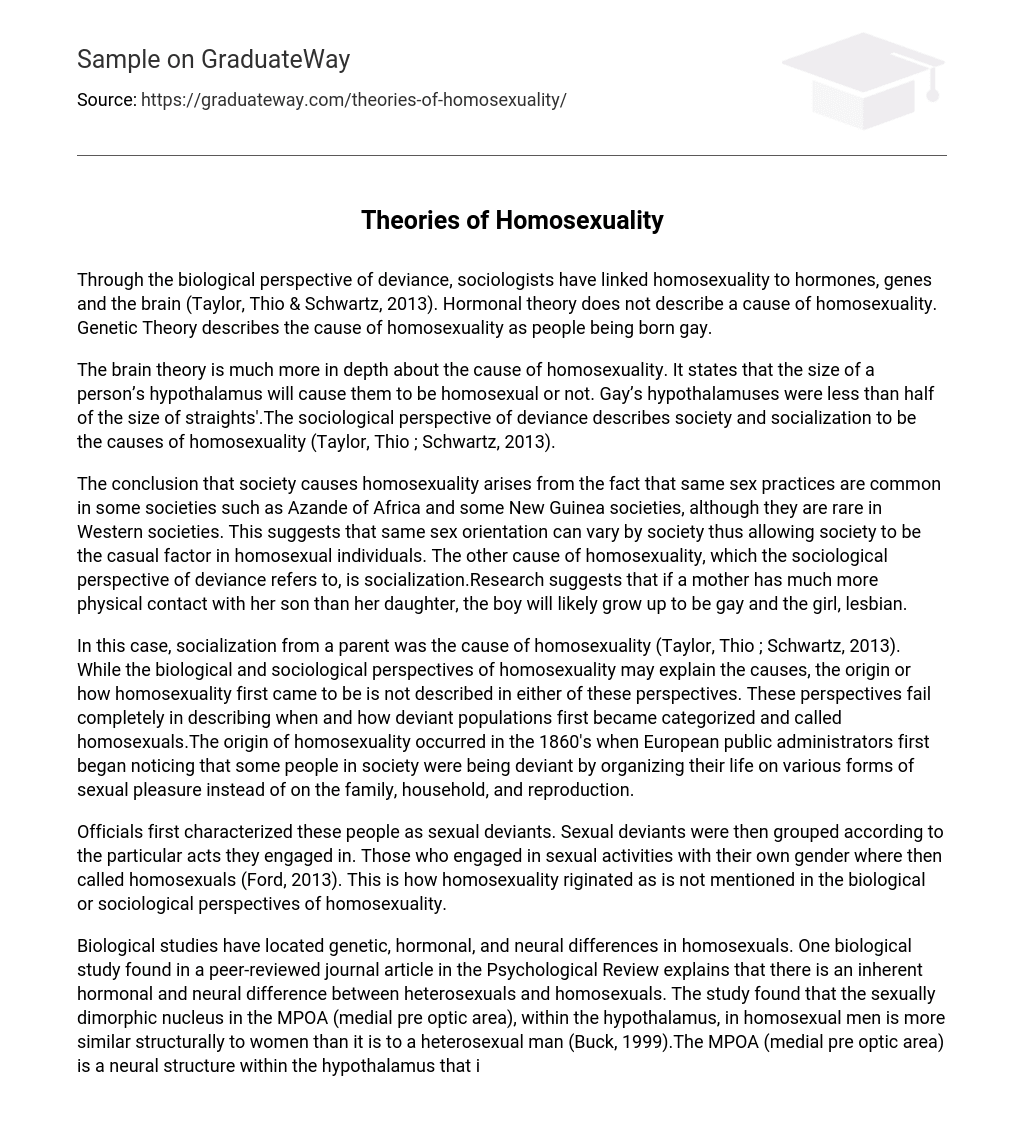Through the biological perspective of deviance, sociologists have linked homosexuality to hormones, genes and the brain (Taylor, Thio & Schwartz, 2013). Hormonal theory does not describe a cause of homosexuality. Genetic Theory describes the cause of homosexuality as people being born gay.
The brain theory is much more in depth about the cause of homosexuality. It states that the size of a person’s hypothalamus will cause them to be homosexual or not. Gay’s hypothalamuses were less than half of the size of straights’.The sociological perspective of deviance describes society and socialization to be the causes of homosexuality (Taylor, Thio ; Schwartz, 2013).
The conclusion that society causes homosexuality arises from the fact that same sex practices are common in some societies such as Azande of Africa and some New Guinea societies, although they are rare in Western societies. This suggests that same sex orientation can vary by society thus allowing society to be the casual factor in homosexual individuals. The other cause of homosexuality, which the sociological perspective of deviance refers to, is socialization.Research suggests that if a mother has much more physical contact with her son than her daughter, the boy will likely grow up to be gay and the girl, lesbian.
In this case, socialization from a parent was the cause of homosexuality (Taylor, Thio ; Schwartz, 2013). While the biological and sociological perspectives of homosexuality may explain the causes, the origin or how homosexuality first came to be is not described in either of these perspectives. These perspectives fail completely in describing when and how deviant populations first became categorized and called homosexuals.The origin of homosexuality occurred in the 1860’s when European public administrators first began noticing that some people in society were being deviant by organizing their life on various forms of sexual pleasure instead of on the family, household, and reproduction.
Officials first characterized these people as sexual deviants. Sexual deviants were then grouped according to the particular acts they engaged in. Those who engaged in sexual activities with their own gender where then called homosexuals (Ford, 2013). This is how homosexuality riginated as is not mentioned in the biological or sociological perspectives of homosexuality.
Biological studies have located genetic, hormonal, and neural differences in homosexuals. One biological study found in a peer-reviewed journal article in the Psychological Review explains that there is an inherent hormonal and neural difference between heterosexuals and homosexuals. The study found that the sexually dimorphic nucleus in the MPOA (medial pre optic area), within the hypothalamus, in homosexual men is more similar structurally to women than it is to a heterosexual man (Buck, 1999).The MPOA (medial pre optic area) is a neural structure within the hypothalamus that is associated with arousal.
This explains why a homosexual is more aroused by men in comparison to women, similar to how a heterosexual women is also aroused by men. Another study that shows evidence for a biological influence in male homosexuality is a journal in the Scientific American by Simon LeVay and Dean H. Hamer (LeVay & Hamer, 1994). This study details how the brains of nineteen homosexual men and sixteen heterosexual men differ from the brains of women.
The sexual orientation of the women used in the study was unknown.INAH3, a nucleus in the brain that is twice as large in men than women, was found to be two to three times larger in heterosexual male’s brains than in those of homosexual men. In fact, the volumes of INAH3 in the homosexual men and in the women were not significantly different. INAH3 is first created while a baby is still a fetus and its size is dependent on circulating androgen.
Also, castration does not change the size of this nucleus, proving that once it is created in the whom the sexual orientation of a male baby is set. This even does not change when a man has virtually no testosterone from castration.Exactly what INAH3 does is unknown, but it could be the sexual orientation area of the brain (Wirth, 2010). Another part of the brain that is found to be the same size in homosexual men and women is the anterior commissure, a bundle of fibers running across the midline of the brain.
In heterosexual men, however, this bundle of fibers is much smaller (LeVay ; Hamer, 1994). A social constructionist view shifts attention to social meanings, rather than the causes, of homosexuality by not seeing homosexuality as real in and of itself, but only as a social construct (Taylor, Thio ; Schwartz, 2013).If homosexuality is not real, it cannot have a cause, thus social constructionists shift their attention to the social construct as well as the social meaning of homosexuality. The social meaning and construct is that society deems same-sex orientation undesirable.
Social constructionists focus on how society treats gays and lesbians, and it views that treatment as what determines how a homosexual will live his or her life. For example, homophobia is a societal reaction to homosexuality, and this interpretation of homosexuality becomes the social meaning that will shape a homosexual’s life. -hani





